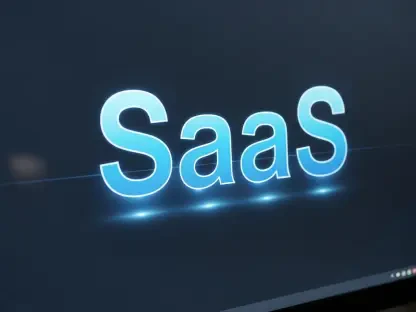The finance and technology sectors are undergoing a significant transformation. The integration of Software as a Service (SaaS) and embedded payments is a game-changer, streamlining business processes, improving payment efficiency, and fostering collaboration across industries, enterprises, and government entities. These innovations are reshaping transactional processes and offering a more seamless experience for all parties involved.
The Rise of SaaS and Embedded Payments
Defining SaaS and Embedded Payments
Software as a Service, or SaaS, provides businesses with cloud-based solutions for managing customer relationships, marketing, communications, and more. Embedded payments refer to the integration of payment functionalities directly into these software platforms, eliminating the need for separate payment systems. These services are becoming increasingly important as they allow businesses to handle transactions more efficiently, making payments a seamless part of daily operations.
SaaS platforms have become ubiquitous across various sectors, offering specialized solutions for different industries. The incorporation of payment functionalities into these platforms has streamlined the transactional processes, reducing errors and making payments more straightforward. This integration enables businesses to manage their entire operations, from marketing to payments, within a single, unified platform, creating a more efficient workflow.
Market Transformation by Vertical SaaS
Vertical SaaS providers are tailoring their solutions for specific industries, from healthcare to real estate. These platforms now include embedded payment systems, allowing businesses to offer easy and efficient payment options where they previously didn’t exist. This focus on industry-specific solutions means that vertical SaaS providers can address unique challenges within particular markets, offering more relevant and effective tools.
This tailored approach has significantly transformed market dynamics, leading to enhanced monetization opportunities and greater efficiency. Businesses can now handle payments and receivables more smoothly, without needing extensive technical investments. By focusing on the specific needs of an industry, vertical SaaS providers can offer features that general SaaS platforms may lack, making them indispensable for businesses looking for specialized solutions.
Efficiency and Monetization Through Embedded Payments
Simplifying Payment Processes
By embedding payment functionalities into SaaS platforms, businesses can simplify their payment processes. This integration reduces manual intervention, minimizing errors, and speeding up transactions. Companies can focus more on their core operations rather than dealing with complex payment setups. For example, automated payment reminders and instant transaction confirmations can significantly reduce the administrative burden on staff, allowing them to concentrate on more strategic tasks.
For enterprises and government entities, this means a more streamlined way to accept payments. The embedded payment systems offer a seamless experience for end customers, enhancing overall satisfaction and operational efficiency. Government entities, in particular, benefit from these streamlined processes as they often need to handle a high volume of transactions, and an integrated payment system can facilitate faster and more accurate processing.
New Revenue Streams and Client Acquisition
The incorporation of payment solutions into SaaS platforms has led to the creation of new revenue streams. For SaaS providers, this means an opportunity to monetize their services in innovative ways. By offering built-in payment solutions, they can attract more enterprise clients who seek comprehensive, affordable options. The ability to offer these additional features sets SaaS providers apart from competitors who may only offer traditional software solutions without integrated payments.
SaaS providers are also able to retain clients more effectively by reducing the upfront financial burdens through flexible payment options. This has led to a surge in client acquisition and retention across various industries. Flexible payment plans can make high-value software more accessible to smaller businesses, allowing them to invest in advanced tools without a significant financial strain upfront. This flexibility also fosters long-term relationships and loyalty, as clients appreciate the adaptability to their payment capabilities.
Real-World Examples of Innovations
Lemon’s Financing Platform
Lemon has introduced a financing platform that addresses customer hesitancy over large upfront costs. By partnering with Shawbrook Bank, Lemon allows buyers to spread payments over time, while sellers can receive full payment upfront. This innovative solution provides a win-win scenario for both parties: customers can afford expensive software by breaking down payments, and sellers improve their cash flow by receiving payments sooner.
This innovative solution has transformed how SaaS sales teams approach potential clients, making it easier for customers to commit to high-value purchases without immediate financial strain. The platform also builds trust and reduces the risk for sellers, knowing they will be paid in full. This financial flexibility can be particularly appealing in industries where large capital expenditures are typical but can be a barrier to entry for many potential buyers.
HubSpot’s Acquisition of Cacheflow
HubSpot’s acquisition of Cacheflow integrates subscription billing management and configure-price-quote (CPQ) tools into its platform. This acquisition simplifies B2B software sales by automating the sales flow process, reducing the complexity and time involved in handling subscriptions and quotes. The introduction of CPQ tools allows for the quick generation of accurate quotes, which can be a time-consuming process, often requiring multiple iterations.
The automation of billing and pricing processes means that sales teams can focus more on client engagement and less on administrative tasks. This has been a significant boon for B2B sales environments, where the sales cycle can be lengthy and complex. By streamlining these processes, HubSpot has effectively reduced the friction in B2B transactions, making it easier for businesses to scale their operations and manage customer relationships.
Cross River Bank and Forward Partnership
Cross River Bank’s partnership with Forward is designed to tackle payment challenges faced by SaaS providers. This collaboration includes same-day ACH payouts, addressing a critical need for quicker, more efficient transaction settlements. Same-day payouts allow businesses to have faster access to their funds, significantly improving cash flow management.
This collaboration underscores the importance of speed and efficiency in today’s fast-paced business environment. By offering same-day ACH payouts, Cross River Bank and Forward are making it easier for SaaS providers to meet the needs of their clients, who often require timely access to funds to manage their own operations effectively. This timely access to funds can be critical for small and medium-sized businesses that rely on regular cash flow for daily operations.
UNIPaaS and American Express Partnership
Targeted at SMBs, the partnership between UNIPaaS and American Express allows customers to pay invoices through American Express. This enhances the speed and efficiency of business payments, providing a seamless experience for small and medium businesses. The ability to use a trusted and widely accepted payment method like American Express gives SMBs confidence in the transaction process.
The collaboration also simplifies the accounting process for SMBs, as payments made through American Express are often easier to track and reconcile. This reduces the administrative burden on small businesses, allowing them to focus more on growth and less on managing complex accounting tasks. The use of American Express also offers additional benefits like extended payment terms and rewards programs, adding further value for SMBs.
Stripe’s Acquisition of Lemon Squeezy
Stripe’s acquisition of Lemon Squeezy marks a significant move towards software-defined financial services. Lemon Squeezy acts as a merchant of record for SaaS companies, managing sales tax computations and global handling, thus offering a comprehensive solution for SaaS providers. This acquisition allows Stripe to offer a more integrated and streamlined financial service.
This acquisition positions Stripe as a more robust and versatile player in the financial services space, enabling SaaS providers to handle global transactions with ease. The integration of sales tax management simplifies compliance for SaaS providers, who often deal with complex tax regulations across different jurisdictions. This move allows Stripe to offer more comprehensive solutions, making it easier for SaaS providers to grow and operate on a global scale.
Cross-Border Payment Challenges and Solutions
Navigating Regulatory Complexities
Getting cross-border payments right involves navigating market volatility, regulatory compliance, and cross-currency risks. Regions like the Asia-Pacific (APAC) pose specific challenges due to currency restrictions, making inbound payment flows complex. Companies doing business in these regions must be well-versed in local laws and regulatory requirements to ensure compliance and avoid potential pitfalls.
The growth in cross-border payments, driven by eCommerce and exports, necessitates robust compliance measures and strategic solutions to mitigate potential risks and ensure smooth transactions. Compliance with international regulations can be challenging, requiring businesses to stay updated on changes and implement systems to manage compliance effectively. Partnering with local experts can also help businesses navigate these complexities more efficiently.
Technological Advancements and Strategic Solutions
The shift towards digital-first models, accelerated by the pandemic, is now a permanent fixture, especially for eCommerce and SMBs. Technologies such as automation and AI play a crucial role in reducing the cost and time associated with processing large volumes of transactions. Automated systems can handle repetitive tasks more efficiently, allowing human resources to focus on strategic initiatives.
Features like guaranteed FX rates and multicurrency netting offer clients real-time rates, streamlining the cross-border payment process and reducing the need for complex hedging strategies. These technological advancements make it easier for businesses to manage risks associated with currency fluctuations, giving them more predictability and stability in their financial planning. This is particularly beneficial for companies operating in multiple countries with different currencies, as it simplifies financial management and reduces uncertainty.
The Role of Interoperability and Standardization
Interoperability between payment networks is essential for the success of cross-border payments. The APAC region, with its advancements in real-time interconnectivity, serves as a model. Efficient interoperability ensures that payments can be processed quickly and accurately, even across different financial systems and jurisdictions.
Adopting the ISO 20022 messaging standard is a critical step toward enhancing interoperability and standardizing communications across financial institutions. This standard improves transparency, reduces errors, and speeds up the payment process. By using a common language for payment instructions, financial institutions can more easily understand and process transactions, leading to greater efficiency and reliability in cross-border payments.
Conclusion
The finance and technology sectors are experiencing a considerable transformation brought on by the integration of Software as a Service (SaaS) and embedded payment solutions. This revolution is profoundly changing the way businesses operate, making processes more streamlined and enhancing payment efficiency. The merge of these two technologies allows for smoother collaboration across different industries, enterprises, and even government entities, creating a more unified and efficient system.
As SaaS becomes more ingrained in the operations of various sectors, it stands out for its ability to simplify complex processes. Businesses can now manage transactions, track payments, and analyze financial data more effectively than ever before. The integration of embedded payments further complements these improvements. This technology embeds payment processing capabilities directly into software platforms, removing the need for third-party applications and making transactions faster and more seamless.
This shift is reshaping transactional processes, offering significant benefits to all parties involved. Companies experience fewer bottlenecks, customers enjoy smoother transactions, and government agencies benefit from quicker, more transparent payment collection methods. Overall, the fusion of SaaS and embedded payments is setting a new standard for efficiency and collaboration, marking a pivotal moment in the evolution of both finance and technology.









